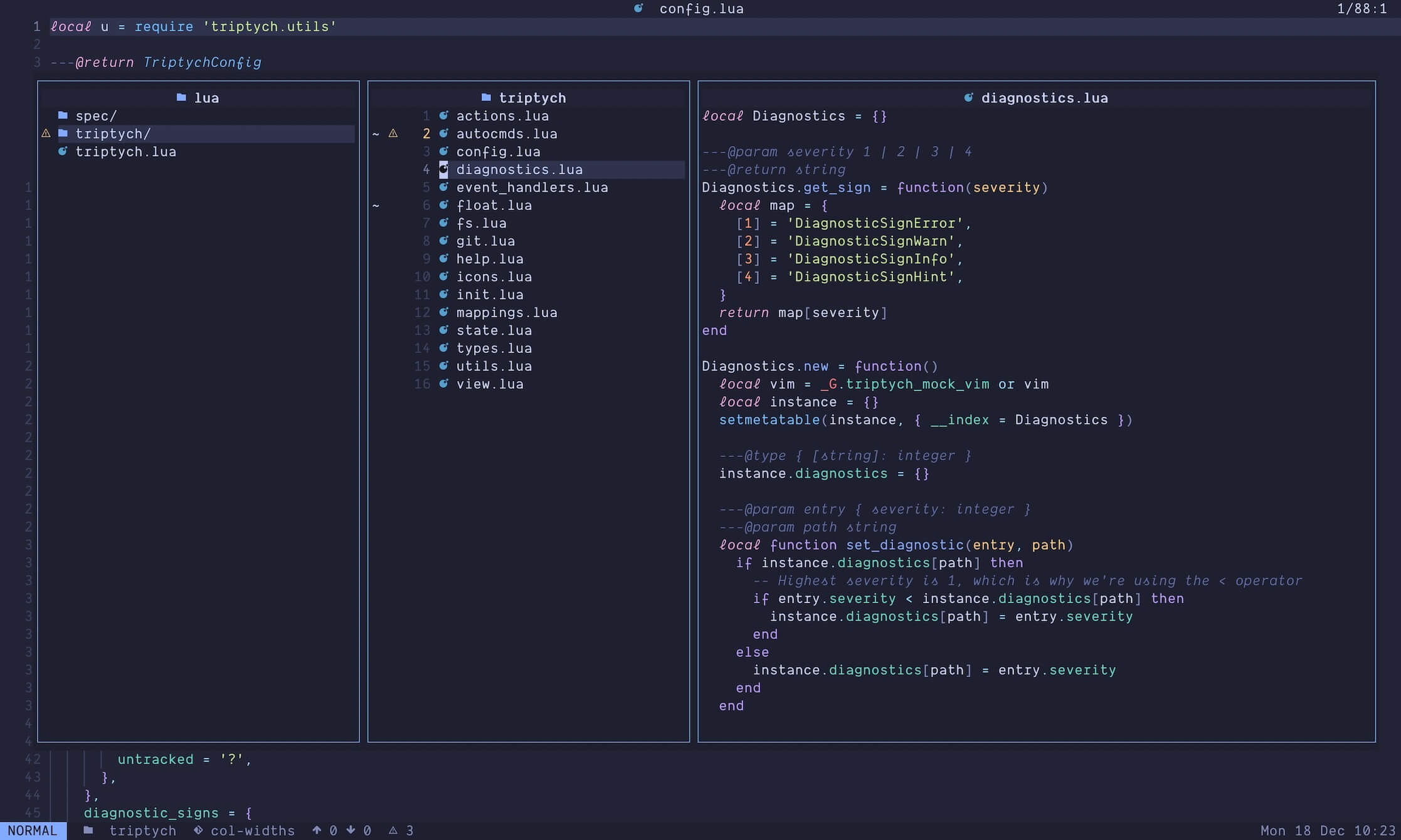simonmclean/triptych.nvim

The UI consists of 3 floating windows. In the center is the currently focused directory. On the left is the parent directory. The right window contains either a child directory, or a file preview.
With default bindings use j and k (or any other motions like G, gg, / etc) to navigate within the current directory.
Use h and l to switch to the parent or child directories respectively.
If the buffer on the right is a file, then pressing l will close Triptych and open that file in the buffer you were just in.
You only ever control or focus the middle window.
✨ Features
- Rapid, intuitive directory browsing
- File preview
- Devicons support
- Git signs
- Diagnostic signs
- Perform common actions on the filesystem
- Rename
- Delete (including bulk)
- Copy 'n' paste (including bulk) [^1]
- Cut 'n' paste (including bulk) [^1]
- Extensible
[^1]: These are not currently working on the Windows operating system
⚡️ Requirements
- Neovim >= 0.9.0
- nvim-lua/plenary.nvim plugin
- Optional, if you want fancy icons
- nvim-tree/nvim-web-devicons plugin
- A Nerd Font
📦 Installation
Example using Lazy.
{
'simonmclean/triptych.nvim',
event = 'VeryLazy',
dependencies = {
'nvim-lua/plenary.nvim', -- required
'nvim-tree/nvim-web-devicons', -- optional
}
}
Then call the setup function somewhere in your Neovim config to initialise it with the default options.
require 'triptych'.setup()
Launch using the :Triptych command, which will toggle Triptych open/closed. You may want to create a binding for this.
vim.keymap.set('n', '<leader>-', ':Triptych<CR>', { silent = true })
⚙️ Configuration
Below is the default configuration. Feel free to override any of these.
Key mappings can either be a string, or a table of strings if you want multiple bindings.
require 'triptych'.setup {
mappings = {
-- Everything below is buffer-local, meaning it will only apply to Triptych windows
show_help = 'g?',
jump_to_cwd = '.', -- Pressing again will toggle back
nav_left = 'h',
nav_right = { 'l', '<CR>' }, -- If target is a file, opens the file in-place
open_hsplit = { '-' },
open_vsplit = { '|' },
open_tab = { '<C-t>' },
cd = '<leader>cd',
delete = 'd',
add = 'a',
copy = 'c',
rename = 'r',
cut = 'x',
paste = 'p',
quit = 'q',
toggle_hidden = '<leader>.',
},
extension_mappings = {},
options = {
dirs_first = true,
show_hidden = false,
line_numbers = {
enabled = true,
relative = false,
},
file_icons = {
enabled = true,
directory_icon = '',
fallback_file_icon = ''
},
responsive_column_widths = {
-- Keys are breakpoints, values are column widths
-- A breakpoint means "when vim.o.columns >= x, use these column widths"
-- Columns widths must add up to 1 after rounding to 2 decimal places
-- Parent or child windows can be hidden by setting a width of 0
['0'] = { 0, 0.5, 0.5 },
['120'] = { 0.2, 0.3, 0.5 },
['200'] = { 0.25, 0.25, 0.5 },
},
highlights = { -- Highlight groups to use. See `:highlight` or `:h highlight`
file_names = 'NONE',
directory_names = 'NONE',
},
syntax_highlighting = { -- Applies to file previews
enabled = true,
debounce_ms = 100,
},
backdrop = 60 -- Backdrop opacity. 0 is fully opaque, 100 is fully transparent (disables the feature)
border = 'single' -- See :h nvim_open_win for border options
},
git_signs = {
enabled = true,
signs = {
-- The value can be either a string or a table.
-- If a string, will be basic text. If a table, will be passed as the {dict} argument to vim.fn.sign_define
-- If you want to add color, you can specify a highlight group in the table.
add = '+',
modify = '~',
rename = 'r',
untracked = '?',
},
},
diagnostic_signs = {
enabled = true,
}
}
Extending functionality
The extension_mappings property allows you add any arbitrary functionality based on the current cursor target.
You simply provide a key mapping, a vim mode, and a function. When the mapped keys are pressed, the function is invoked and is passed two arguments:
A table describing the current cursor "target", and a function which refreshes the view. The target table looks as follows:
{
dirname, -- e.g. /User/Name/foo
display_name -- e.g. 'bar.js'
filetype, -- e.g. 'javascript'
is_dir, -- boolean indicating whether this is a directory
path, -- e.g. /User/Name/foo/bar.js
}
Examples
Telescope integration
If you want to make <c-f> search the file or directory under the cursor using Telescope try something like:
{
extension_mappings = {
['<c-f>'] = {
mode = 'n',
fn = function(target, _)
require 'telescope.builtin'.live_grep {
search_dirs = { target.path }
}
end
}
}
}